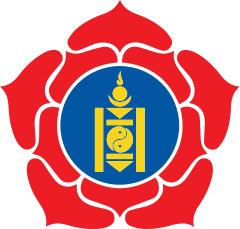More languages
More actions
Mongolian People's Party Монгол Ардын Нам | |
|---|---|
 | |
| Founded | 25 June 1920 |
| Political orientation | Social democracy Formerly: Marxism–Leninism |
The Mongolian People's Party (MPP) is a social-democratic party in Mongolia. Until 1990, it was a communist party known as the Mongolian People's Revolutionary Party (MPRP).
History
Formation
A joint meeting of Damdin Sükhbaatar's revolutionary group and Khorloogiin Choibalsan's Consul Group unified on 1920 June 25 to form the MPP. The initial party oath required each member to recruit at least 10 other members.[1]:279–80
Three days after the party was founded, Choibalsan and Soliin Danzan left to visit Russia. A second group of Sükhbaatar, Dogsom, Losol, Bodoo and Chagdarjav left soon after and met up with the first group on July 22 in Verkhneudinsk (now Ulaan-Üde) before going to Irkutsk. The party created a statement saying they would restore Mongolia's autonomy and abolish the rights of the feudal princes within two years while keeping the Bogd Khan as the nominal head of state. Some party members did not want to ally with the Bolsheviks, including Bodoo, who represented the feudal officials, and Danzan, who represented the small bourgeoisie. In August, Danzan, Losol, and Chagdarjav went to Moscow while Bodoo and Dogsom returned to Örgöö and Sükhbaatar and Choibalsan stayed in Irkutsk.[1]:280–2
The group that arrived in Moscow met Lenin, who said that Mongolia had to seek independence and ally with the workers and peasants of Russia. He criticized Danzan's nationalist views. In Mongolia, Bodoo began collaborating with Ungern's feudal dictatorship.[1]:285–6
First Congress
Choibalsan prepared for the Congress in Örgöö after returning from northern Mongolia. On 1921 March 1, the MPRP held the congress in Hiagt with 26 delegates, mostly from the peasantry. Most of the delegates wanted to ally with Russia and remain independent from the nobility, but a few sided with the nobility and believed Ungern had already restored Mongolia's autonomy from China. The party adopted a program calling for the formation of peasant assemblies (hural) and the overthrow of the Russian Whites and the Chinese warlords. The Congress also combined all the partisan groups into the People's Revolutionary Army, with Sükhbaatar as its commander-in-chief and Choibalsan as commissar. It also elected Danzan, Losol, and Dambadorj to the Central Committee.[2]:289–92
People's Revolution
See main article: Mongolian People's Revolution
On March 13, the Party held a meeting of workers and partisans and elected the Provisional People's Government, with Chagdarjav as president. The government also included Sükhbaatar (Minister of War), Choibalsan (Deputy Commander of Political Affairs), Bilegsaikhan, Bodoo, Sumya, and others.[2]:292–3
In November 1921, Lenin discouraged the newly founded MPP from changing its name to a communist party until the Mongolian proletariat embraced communism. In 1924, the party joined the Comintern as the Mongolian People's Revolutionary Party.[3]
References
- ↑ 1.0 1.1 1.2 A. A. Guber, et al. (1973). History of the Mongolian People's Republic: 'The Mongolian People's Revolution and the Proclamation of the Mongolian People's Republic' (pp. 278–81).
- ↑ 2.0 2.1 A. A. Guber, et al. (1973). History of the Mongolian People's Republic: 'The Mongolian People's Revolution and the Proclamation of the Mongolian People's Republic' (pp. 286–8).
- ↑ Vijay Prashad (2017). Red Star over the Third World: 'Enemy of Imperialism' (p. 80). [PDF] New Delhi: LeftWord Books.
